Depending on the road conditions Lake Nakuru National Park is a 2-4 hr drive from Nairobi in the Southern part of Kenya's rift Valley. Its elevation is 1754m AMSL. If you wish to see the views from the Rift valley escarpment including Mt Suswa and Mt Longonot, then take the Old Road. Be aware of the very heavy and slow lorry traffic with some unbelievable bad driving.
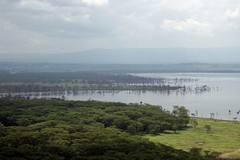
You can see the extent to which the lake has
risen by looking at the lines of drowned trees.
Also apparent is how close Nakuru town is to
the Northern end of the Park. Compare with
the photo below which was taken in 2005
The Park is located very close to Nakuru town and so it doesn't exactly feel like you are out in the wilds as you enter it. However, a half mile in and it's a totally different world. Nakuru means "dust or dusty place" in the Maasai language.
This is only a small park but classed as a Premier park in Kenya (The other is Amboseli). Its area is only 188sq km and it is fenced, so don't expect to see elephants as it's not really big enough to support them. The fence is there to provide security to the townspeople from wildlife and also to help protect the rhinos in the park from poachers. Both black and white rhinos are present. The whites at least are easy to spot as they are grazers. The black rhinos live in thick bush most of the time and are much harder to find.
Climate. The rift valley is generally warm all year round,
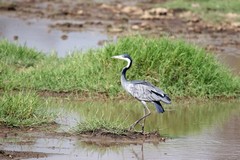
Lake Nakuru is a Ramsar site - an
internationally recognised important wetland.
There is a lot of birdlife around and on the lake
including this Black-headed heron
even in June when Nairobi is relatively cool.
Rains come in two phases; short rains in October to December and again in March to June. Rainfall amount is 965 mm per annum.
Eleven major ecological habitats are represented, ranging from the lake and the mud flats and salt marshes surrounding it, to mosaics of open and wooded grassland, dense forest, bush and cliff habitats One of them - baboon cliffs has a large viewpoint which offers great views of the lake and also is an easy place to spot the hyraxes on the rocks.
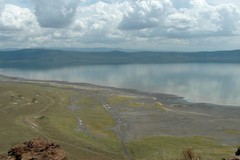
This photo was taken from the Baboon cliff
lookout in 2005. Back then there was no fence.
Notice that there is much more exposed plain
and the lake is a lot shallower. Notice also the
pink ribbon of flamingos
The Park centres around the lake. Nakuru is higly alkaline and used to be quite shallow, although there was a fair amount of variability in levels. However in 2014 the lake flooded and levels came up so much that the entrance buildings had to be relocated further back and up the hill from the lake. This is not entirley understood but there may be other geological factors involved such as a change in the water table level.
The knock on effect of this is that the huge flocks of flamingos that were a major feature of the lake have largely disappeared to lakes Bogoria and Elementaita. Occasionally flocks will arrive but the lack of cyanobacteria (food) growth and the increase in depth of water has put off the huge numbers that used to be there for most of the time.
There is also a small fish, the Lake Magadi tilapia, living in
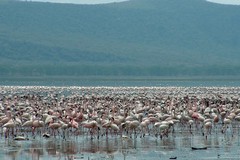
Lake Nakuru was world famous for the two
types of flamingos (greater and lesser) that
lived here in their millions. Since the lake level
rose in 2014 they have largely moved on to
lakes Bogoria, Elementaita and Natron,
although they may return periodically
the lake. It was introduced in the 1960s, and thrived on the cyanabacteria which also fed the flamingos. In turn it supported a large population of white pelicans and cormorants. Since there is now less cyanobacteria growing I'm not sure what the effects on these species will be.
The geology of Lake Nakuru and its catchment area comprises volcanic rocks (lava flows and pyroclastics) of the Tertiary-Quaternary age, which have been affected by a series of faulting episodes. The soil also is of volcanic origin. The sodium carbonate in the alkaline soils is carried to the lake by rainwater. As there is no natural outflow the sodium builds up in the lake.
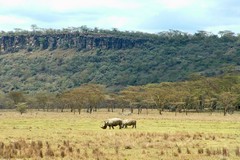
White rhinos are usually easy to spot as they
graze on the grassy plains. Black rhinos tend
to hide in the thick bush in the hills
Wildife viewing is easy. Nakuru is noted for black and white rhinos, and Rothschild's giraffes (also known as Lake Baringo giraffes). It is also a good place to see huge rock pythons if you are lucky. Also present are Defassa waterbuck and mountain reedbuck.
Of course there are many of the more common mammals such as buffalos, zebras, impala, and both Thompson's and Grant's gazelles. The Thompson's gazelles are less evident in the rainy season when the grass is too long for them. There are also lions and leopards resident. The lions like to sleep in the trees. It's also worth looking in the fever trees for black and white colobus monkeys. Baboons are very common.
Over 400 species of birds have been recorded along with 70 mammal species and 550 plant species. The lake echoes to the sound of the fish eagle - known as the Voice of Africa.
Listen to the Voice of Africa -
The park roads are generally good and most people do
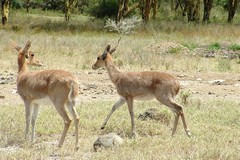
A couple of female mountain reedbucks.
They live along the Rift valley mostly at altitudes
above 1500m
a self drive. It gets busy at times. But if you only have chance for a day's safari from Nairobi then it's worth a visit.
Threats - illegal logging in the catchment area around the park, and over extraction of water from the rivers that feed the lake from the south and also too many boreholes in the area. Rhino poachers.
It's a great place for photography, both scenically and for the well habituated wildlife.